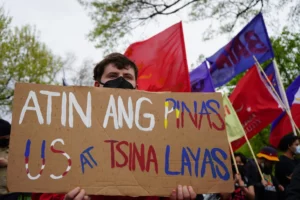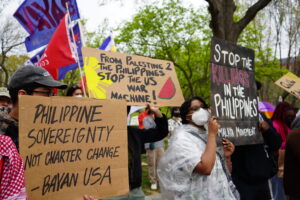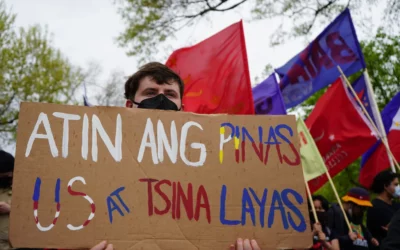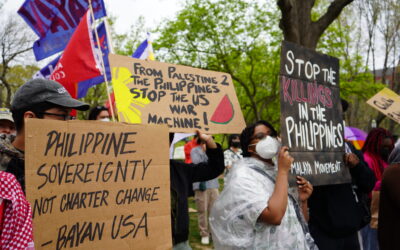AFGHANISTAN: A CASE STUDY IN AMERICAN AGGRESSION
by Angelo Karlo T. Guillen
On April 14 of this year, US President Joe Biden announced the final withdrawal of all American forces from Afghanistan by September 11, to coincide with the 20th anniversary of the 9/11 terrorist attacks.
Trillions in debt, growing anti-war sentiments at home, threats to its global supremacy coming from countries like China and Russia, and the sheer resilience of Afghans determined to expel foreign troops from their soil have all forced America to negotiate a deal with the Taliban for the withdrawal of US troops.
Officially, the United States expresses confidence in the Afghan government’s ability to repel the insurgency. Unofficially, American defense officials concede that the Taliban might return to power within a year or the country may fall into a civil war.
In the three months since Biden’s address, the Taliban advanced at breathtaking speed, capturing large swathes of territory, and are threatening to retake major urban centers. Those who collaborated with US forces are being airlifted out of the country, and the US-backed regime of Afghan President Ashraf Ghani is now desperately fighting to maintain control.
With these prospects, old questions are re-emerging about the justness of America’s post-9/11 military campaigns, why the United States had to punish an entire nation for acts attributed only to Osama bin Laden and Al Qaeda, and how two decades of foreign occupation transformed the lives of ordinary Afghans for the worse.
At the very least, recent events serve as a reminder of the devastation brought by the so-called “war on terror”.
Since the United States and its allies invaded Afghanistan in 2001, more than 70,000 civilians have died from the fighting and hundreds of thousands more from hunger and disease. More than 6 million Afghans have also been displaced.
After decimating it with relentless bombardment, the United States devoted only a measly 6 percent of its entire war budget to rebuilding Afghanistan. It also forced free-market solutions on a war-torn economy, and pushed the Afghans to adopt American-style governance without taking into account the country’s political and socio-cultural setting.
The folly in these policies is apparent in the results. Twenty years on and all the United States has to show for its nation-building efforts is a new Afghan regime marked by corruption and abuse, reliant on foreign aid, ruling a country with half the population mired in poverty and food insecurity.
Beyond the desolation brought by the war, the United States also leaves behind a legacy of human rights abuses and war crimes that scarred not just the Afghans, but also the people of Iraq, Pakistan, Yemen, Somalia and other countries that became victims of its aggression.
Foreign nationals were abducted, imprisoned for years without trial, and tortured in military facilities and CIA “black sites” under US rendition and detention programs.
With its preference for highly-destructive airstrikes, the United States is responsible for killing and maiming thousands of civilians, including children. For people living in the Afghan or the Pakistani countryside, terror comes in the form of American Reaper drones and Hellfire missiles.
Despite attempts by the United States to portray its actions as components of a global fight against terrorism, its flagrant and repeated breach of international law and basic rules of war have betrayed those attempts as hypocritical and deceitful.
The use of sophisticated technology to target and kill civilians and the inhumane treatment of prisoners under secret programs designed to circumvent the Geneva Convention have also introduced the world to America’s own brand of state terrorism.
Its subsequent attack on Iraq – based on false claims that the Hussein regime had weapons of mass destruction – and other military endeavors in the Middle East have since confirmed that America’s military campaigns were less about championing “freedom and democracy” and more about protecting its oil interests in the region.
Taken in historical context, the 2001 invasion of Afghanistan was wholly consistent with an American foreign policy of aggression and intervention intended to serve its political and economic ends.
In the last century, across Asia, South America, Africa, and the Middle East, millions of lives were lost in wars and purges triggered by the United States either by military action or covert operations carried out by its intelligence and diplomatic agencies.
Afghanistan was never the first victim of US foreign policy – only one of the latest. It behooves other countries to carefully study its experience because the cost of American intervention is enormous, and the Afghans are paying dearly for it today and will likely continue to do so in the foreseeable future.
This series takes a closer look at the US military campaign in Afghanistan, the human and social cost of that war, the human rights violations committed by US forces under the guise of anti-terrorism operations, and how American foreign policy has plagued numerous countries around the world. ####
——
The author is a human rights lawyer, the Assistant Vice President for the Visayas of the National Union of Peoples’ Lawyers, and the Secretary-General of NUPL’s Panay Chapter.

![AFGHANISTAN: A CASE STUDY IN AMERICAN AGGRESSION by Angelo Karlo T. Guillen On April 14 of this year, US President Joe Biden announced the final withdrawal of all American forces from Afghanistan by September 11, to coincide with the 20th anniversary of the 9/11 terrorist attacks. Trillions in debt, growing anti-war sentiments at home, threats to […]](https://www.altermidya.net/wp-content/uploads/2021/08/PT-Afghanistan-pt1.png)








0 Comments